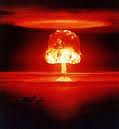The Iran Nuclear Threat: Phantom Menace

They say you can’t kill that which has never lived. It’s useful advice when analyzing the persistence of the so-called “Iranian nuclear threat.”
According to a report in McClatchy, “Israeli intelligence officials now estimate that Iran won’t be able to build a nuclear weapon before 2015 or 2016.”
Recall that just this past September Israeli Prime Minister Benjamin Netanyahu was theatrically warning that Iran would achieve nuclear weapons capability by “next spring, at most by next summer.”
Of course, Netanyahu has made a career out of warning that Iran is about to go nuclear – claiming as early as 1992 that Iran was 3 to 5 years away from being able to produce a bomb
As one Israeli official justifiably lamented to McClatchy, “Did we cry wolf too early?” Yes – early and often, to be precise.
“There has not been the run towards a nuclear bomb that some people feared,” the Israeli official went on to note. “There is a deliberate slowing on their [Iran’s] end.”
The fact that Iran has made no run towards a bomb should come as no surprise. After all, both U.S. and Israeli intelligence estimates have repeatedly found that Iran is not pursuing a bomb.
Moreover, it’s been nearly a year now since Iranian Supreme Leader Ayatollah Khamenei first issued a fatwa against nuclear weapons.
“The Islamic Republic,” Khamenei declared back in early 2012, “logically, religiously and theoretically, considers the possession of nuclear weapons a grave sin and believes the proliferation of such weapons is senseless, destructive and dangerous.”
Speaking earlier this month, Iran’s Foreign Ministry Spokesman Ramin Mehmanparast reiterated that Khamenei’s fatwa is binding.
“There is nothing more important in defining the framework for our nuclear activities than the Leader’s fatwa,” Mehmanparast stated. “This fatwa is our operational instruction.”
Contrast, then, the Iranian nuclear posture with that of the U.S. and Israel – the two supposedly threatened parties.
Israel has perhaps as many as 200 nuclear weapons. It is unknown precisely just how many bombs Israel possesses because it refuses to sign the Non-Proliferation Treaty (which Iran has done), or allow in international inspectors (which Iran continues to do).
Meanwhile, the U.S. – the only nation to actually deploy nuclear weapons in combat – is currently in the midst of upgrading its arsenal of 5,113 nuclear warheads. With conservative estimates approaching $400 billion, the Washington Post reports, it will be the “costliest overhaul in its history.”
And yet, it is Iran that poses the nuclear threat.
In fact, Netanyahu, in defiance of his country’s own intelligence, continues to this day to warn of “Iran’s race to achieve nuclear capability.”
The Iranian nuclear threat simply cannot be killed. And as it is permitted to linger, the U.S. military planning against Iran continues its acceleration.
As former Israeli Defense Minister Ehud Barack revealed in a recent interview with the Daily Beast, the Pentagon has drawn up detailed plans for a “surgical operation” against Iran – what Barack deemed “scalpels.”
It’s worth noting, however, that much of the speculation on a possible U.S. strike against Iran has centered on the use of the Pentagon’s Massive Ordnance Air Blast weapon. At 30,000 pounds, the “mother of all bombs,” as it is known, is the “largest non-nuclear weapon in the U.S. military arsenal.”
Clearly, the definition of what constitutes a “surgical operation” is becoming ever more flexed.
The Israeli daily Haaretz, meanwhile, reports that the Pentagon has just deployed six F-22 Raptor fighters to the Al-Dhafra Airbase in the United Arab Emirates.
The F-22, as Haaretz notes, is the “most advanced fighter currently in operational use by the United States Air Force and the only operational ‘stealth’ fighter in use around the world with the capability to evade enemy radar systems.”
The Pentagon originally deployed the F-22s to its UAE airbase last April, but claimed at the time that their deployment was to be temporary. But after nine months, and a reinforcement of the warplanes, the deployment appears to be quite permanent.
It is again useful to compare Washington’s military posture in the Gulf to that of Tehran.
As an April Pentagon report found, Iran’s defense doctrine remains one of self-defense. Iran’s military capacity, the report notes, is designed specifically to “slow an invasion” and “force a diplomatic solution to hostilities.”
The stationing of the stealth fighters in the UAE, along with a naval armada in the waters of the Persian Gulf, makes it abundantly clear what the U.S. defense doctrine is designed for.
It’s clear, then, the Iranian nuclear threat is but a phantom menace. And that, in part, explains its enduring presence. You can’t kill that which has never lived.
Ben Schreiner is a freelance writer living in Salem, Oregon. He may be reached at: [email protected]

